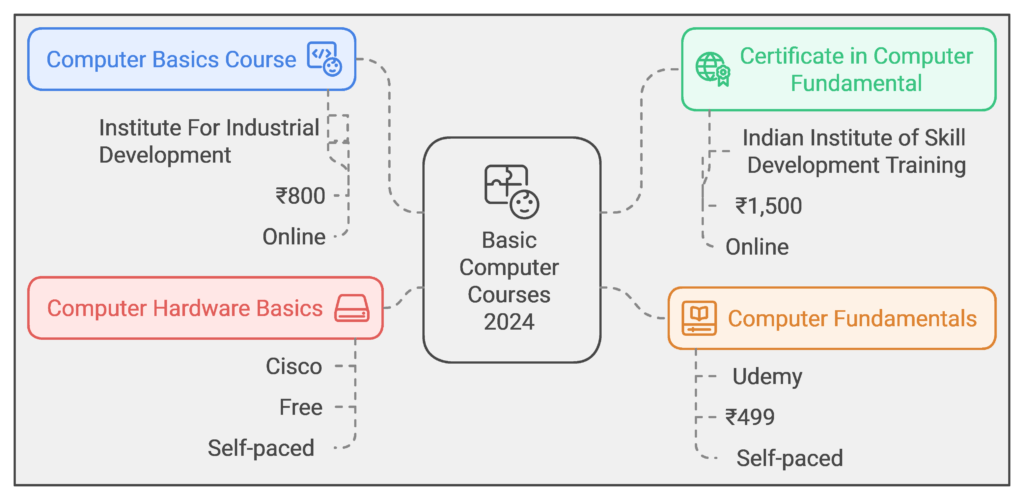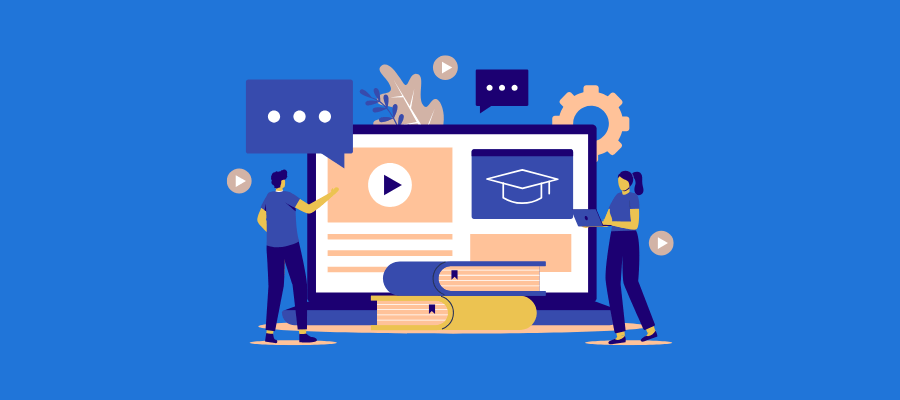Looking to gain essential computer skills? The Basic Computer Course syllabus covers everything from the fundamentals of hardware and software to advanced applications like Microsoft Office and internet usage. With hands-on projects such as creating a personal resume and developing a simple database, this guide outlines the curriculum, course duration, fees, and eligibility criteria to help you get started in the 2024-2025 academic session.
Whether you’re a beginner or want to enhance your digital literacy, this course is designed for all skill levels.
Download Basic Computer Course Syllabus
In a hurry? Download the complete Basic Computer course syllabus
Basic Computer Course Syllabus and Curriculum
Here’s a Basic Computer Course syllabus at a glance:
| Sl No. | Module Name | Topics Covered | Hands-On Projects |
|---|---|---|---|
| 1 | Introduction to Computers | – Definition and Purpose – Types of Computers – Basic Components | 1. Develop a Simple Database 2. Personal Budget Tracker 3. Email Communication Project 4. Create a Personal Resume |
| 2 | Computer Hardware | – Overview of Parts – Input Devices – Output Devices – Peripherals | |
| 3 | Software Fundamentals | – Definition and Types – Overview of Operating Systems -Installation/ Uninstallation | |
| 4 | Operating Systems | – Basics and Functions – File Management – User Interface Navigation – System Settings | |
| 5 | Microsoft Office Suite | – Microsoft Word – Document Creation – Formatting – Microsoft Excel – Spreadsheets – Charts – Microsoft PowerPoint – Presentations | |
| 6 | Internet and Web Browsing | – Introduction to the Internet- Web Browsers- URLs and Search Engines- Online Safety- Cloud Storage | |
| 7 | Email and Communication | – Setting Up Email- Sending/Receiving Emails- Email Etiquette- Collaboration Tools | |
| 8 | Basic Networking Concepts | – Computer Networks- Networking Devices- Internet Connectivity- Wi-Fi Setup | |
| 9 | Financial Literacy for Banking Schemes | – Importance of Savings- Banking Products- Banking Services- Government Schemes- KYC- Security Measures | |
| 10 | Digital Literacy and Safety | – Digital Footprints- Phishing and Scams- Safe Browsing- Cybersecurity Basics | |
| 11 | Practical Applications | – Managing Folders/Files- Restoring Deleted Files- Troubleshooting Techniques- Virtual Learning | |
| 12 | Advanced Software Applications | – Graphic Design Software- Video Editing Software- Programming Concepts- Databases |
Module 1: Introduction to Computers
- Definition and Purpose of Computers
- Types of Computers (Desktop, Laptop, Tablet, etc.)
- Basic Components of a Computer (CPU, Memory, Storage)
Module 2: Computer Hardware
- Overview of Computer Parts (Motherboard, Hard Drive, RAM, etc.)
- Input Devices (Keyboard, Mouse, Scanner)
- Output Devices (Monitor, Printer, Speakers)
- Understanding Peripherals and Their Functions
Module 3: Software Fundamentals
- Definition of Software and Its Types (System Software, Application Software)
- Overview of Operating Systems (Windows, macOS, Linux)
- Installation and Uninstallation of Software
Module 4: Operating Systems
- Basics of Operating Systems and Their Functions
- File and Directory Management
- User Interface Navigation (Desktop, Taskbar, Start Menu)
- System Settings and Control Panel
Module 5: Microsoft Office Suite
Microsoft Word
- Document Creation and Editing
- Formatting Text and Paragraphs
- Using Templates and Styles
- Saving and Printing Documents
Microsoft Excel
- Introduction to Spreadsheets
- Basic Formulas and Functions
- Creating Charts and Graphs
- Data Analysis Tools (Sorting, Filtering, PivotTables)
Microsoft PowerPoint
- Creating Presentations
- Slide Formatting and Transitions
- Using Multimedia in Presentations
- Collaboration and Sharing Options
Module 6: Internet and Web Browsing
- Introduction to the Internet and World Wide Web
- Using Web Browsers (Chrome, Firefox, etc.)
- Understanding URLs and Search Engines
- Basics of Online Safety and Security
- Cloud Storage Solutions (Google Drive, Dropbox)
Module 7: Email and Communication
- Setting Up an Email Account
- Sending, Receiving, and Organizing Emails
- Understanding Email Etiquette
- Using Collaboration Tools (Slack, Microsoft Teams)
Module 8: Basic Networking Concepts
- Computer Networks (LAN, WAN)
- Networking Devices (Routers, Switches)
- Basics of Internet Connectivity
- Wi-Fi Setup and Troubleshooting
Module 9: Financial Literacy for Banking Schemes
- The Importance of Savings and Reasons for Saving in a Bank
- Various Banking Products (ATM Cards, Cheques, Demand Drafts)
- Banking Services and Delivery Channels (Mobile Banking, Loans, Remittances)
- Government Schemes (Pradhan Mantri Jan Dhan Yojana, etc.)
- Understanding KYC (Know Your Customer) Requirements
- Security Measures for Online Banking and ATM Usage
- Overview of Social Security Schemes (e.g., Atal Pension Yojana)
Module 10: Digital Literacy and Safety
- Understanding Digital Footprints and Online Privacy
- Recognizing Phishing and Online Scams
- Safe Browsing Practices
- Cybersecurity Basics (Antivirus, Firewalls)
Module 11: Practical Applications
- Creating and Managing Folders and Files
- Restoring Deleted Files from the Recycle Bin
- Basic Troubleshooting Techniques for Common Computer Issues
- Using Virtual Learning Environments (e.g., Google Classroom)
Module 12: Advanced Software Applications
- Introduction to Graphic Design Software (Canva, Photoshop)
- Basics of Video Editing Software (iMovie, Windows Movie Maker)
- Introduction to Programming Concepts (Python, Scratch)
- Using Databases (Microsoft Access, Google Sheets)
⭐ Hands-on projects to practice:
- Develop a Simple Database: Using Microsoft Access or Excel to manage contacts or inventory, create a basic database.
- Set up fields such as Name, Phone Number, Email, and Address.
- Input data for at least 10 entries.
- Create a query to sort or filter the data based on specific criteria.
- Personal Budget Tracker: Develop a budget tracker using Microsoft Excel or Google Sheets.
- Create a spreadsheet with categories for income and expenses.
- Use formulas to calculate total income, total expenses, and remaining balance.
- Include charts to visualize spending patterns over time.
- Email Communication Project: Set up an email account and create a professional email communication.
- Draft a professional email requesting information or feedback from a fictional company.
- Include a subject line, greeting, body, and closing.
- Send the email to a friend or family member for feedback on clarity and professionalism.
- Create a Personal Resume: Design a professional resume using Microsoft Word.
- Use built-in templates or create a custom layout.
- Include sections for personal information, education, work experience, and skills.
- Format the document for clarity and professionalism.
Basic Computer course subjects and topics to learn
Basic computer courses include general operational knowledge of a few daily tasks like managing documents, connecting people via emails, solving internet issues, maintaining personal accounts, etc. Some of the essential topics and subjects to learn for such courses are listed below.
Knowledge of Computers
The first thing to know in a basic computer course is about computers, their history and types, and the different components of a computer.
You must see the use of a keyboard and mouse, how to connect them to your machine, knowledge of computer memory, connect all devices with the CPU, etc. This gives you a better understanding of how computers work.
Operating System Basics
Most of the computer courses teach you about Windows and Linux operating systems. It is a program installed into your computer to manage all other application programs on it.
You will be introduced to different operating systems and understand the basic operations like opening and closing different windows, file management, creating and renaming folders and directories, system settings, creating shortcuts, and creating user interfaces.
Microsoft Suite
Learn to create simple and complex documents, letters, reports, etc., in Microsoft Word, a word processor developed by Microsoft. This course covers creating, editing, and formatting documents, using templates, inserting images, creating tables, etc.
Also, learn using Microsoft Excel to create and format spreadsheets, perform basic calculations, and analyze data. Some courses introduce you to Microsoft PowerPoint for creating and designing presentations. You can also learn its advanced features of using animations, transitions, and multimedia elements.
Knowledge of the Internet and Web Browsing
This knowledge helps you to connect with the internet, access amounts of information and resources online, and understand how to efficiently and safely browse using search engines. You will learn about using web browsers, search engines, URLs, bookmarks, browsing history, internet connectivity-related troubleshooting, and more.
Use of Email and Communication
Learning these topics in the basic computer course ensures you can connect with others by sending personal or professional emails. You will learn about creating an email account, the basics of emails, its features, sending and receiving emails, organizing emails, document collaboration, email etiquette, etc.
Basic Networking
Basic networking concepts that are mainly included in the course are LAN, WAN, MAN, network protocols, connecting to and using Wi-Fi networks, use of routers, basic network troubleshooting and setup, etc. This knowledge helps you understand how devices communicate in a network.
Digital Literacy and Safety
Digital literacy teaches you to be cautious while clicking on links or downloading files online and to use digital tools and resources effectively for communication, collaboration, creating, and solving problems.
A basic computer course usually consists of digital literacy and safety lessons to educate students on the risks related to online activities and to protect themselves.
Basic computer course fees and duration 2024

| Course Name | Course Provider | Course Duration | Course Fees | Training Mode |
| Computer Basics Course | Institute For Industrial Development | 173+ hours | ₹800 | Online |
| Certificate in Computer Fundamental | Indian Institute of Skill Development Training | 90 hours | ₹1,500 | Online |
| Computer Fundamentals | Udemy | 2+ hours | ₹499 | Self-paced |
| Computer hardware basics | Cisco | 6 hours | Free | Self-paced |
What is the course fee for basic computer courses?
The course fee for basic computer courses is ₹499 – ₹2000. This fee structure can vary, and you can find basic courses for free on different government skill development websites.
The course fees mainly depend on the type of course, syllabus content, number of practical sessions, experience of the trainers, location and reputation of the institute, etc.
Basic computer Course Duration
These are usually 1 month to 3 months courses. However, if you are enrolling for self-paced basic computer courses, you can complete them at your own learning pace. Courses with multiple topics and basic to advanced curricula usually take a larger timeframe than basic courses.
Who is eligible for the Basic Computer Course?
There are generally no specific educational requirements and no age restriction for enrollment.
A basic understanding of the English language and elementary mathematics skills is typically preferred.

Somrita Shyam is a content writer with 4.5+ years of experience writing blogs, articles, web content, and landing pages in multiple domains. She holds a master’s degree in Computer Application (MCA) and is a Gold Award winner at Vidyasagar University. Her knowledge of the tech industry and experience in crafting creative content helps her write simple and easy-to-understand tech pieces for readers of all ages. Her interest in content writing began after helping PhD scholars in submitting their assignments. Later in 2019, she started working as a freelance content writer at Write Turn Services, and has worked with numerous clients, before joining Experlu (An UK based accounting firm) in 2022 and working as a full-time content writer in GigDe (2022-2023).

